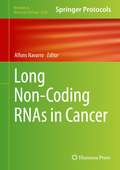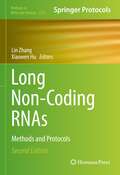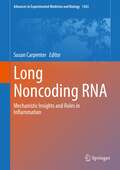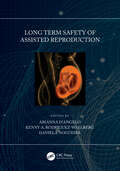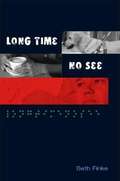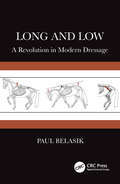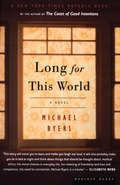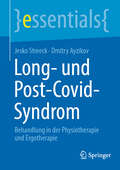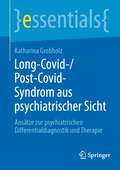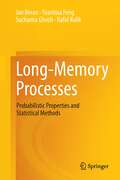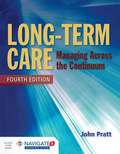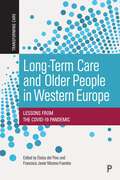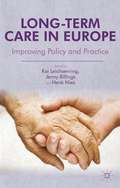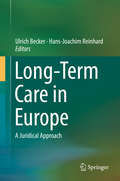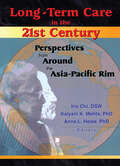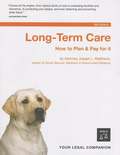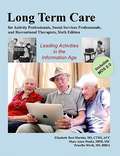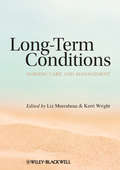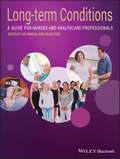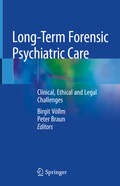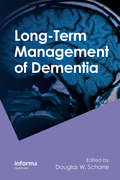- Table View
- List View
Long Non-Coding RNAs in Cancer (Methods in Molecular Biology #2348)
by Alfons NavarroThis volume presents techniques needed for the study of long non-coding RNAs (lncRNAs) in cancer from their identification to functional characterization. Chapters guide readers through identification of lncRNA expression signatures in cancer tissue or liquid biopsies by RNAseq, single Cell RNAseq, Phospho RNAseq or Nanopore Sequencing techniques; validation of lncRNA signatures by Real time PCR, digital PCR or in situ hybridization; and functional analysis by siRNA or CRISPR based methods for lncRNA silencing or overexpression. Lipid based nanoparticles for delivery of siRNAs in vivo, lncRNA-protein interactions, viral lncRNAs and circRNAs are also treated in this volume. Written in the format of the highly successful Methods in Molecular Biology series, each chapter includes an introduction to the topic, lists necessary materials and reagents, includes tips on troubleshooting and known pitfalls, and step-by-step, readily reproducible protocols. <P><P> Authoritative and practical, Long Non-Coding RNAs in Cancer aims to provide a collection of laboratory protocols, bioinformatic pipelines, and review chapters to further research in this vital field.
Long Non-Coding RNAs: Methods and Protocols (Methods in Molecular Biology #2372)
by Lin Zhang Xiaowen HuThis second edition provides a broad spectrum of methods used in long non-coding RNAs (lncRNA) research, ranging from computational annotation of lncRNA genes to molecular and cellular analyses of the function of individual lncRNA. Chapters guide readers through studies used to circular RNAs, RNA splicing, and findings on lncRNA in human diseases. Written in the highly successful Methods in Molecular Biology series format, chapters include introductions to their respective topics, lists of the necessary materials and reagents, step-by-step, readily reproducible laboratory protocols, and tips on troubleshooting and avoiding known pitfalls. Authoritative and cutting-edge, Long Non-Coding RNAs: Methods and Protocols,Second Edition aims to ensure successful results in the further study of this vital field.
Long Noncoding RNA: Mechanistic Insights and Roles in Inflammation (Advances in Experimental Medicine and Biology #1363)
by Susan CarpenterThis book brings together what is currently known in terms of basic research in the field of long noncoding RNAs (lncRNAs) and builds on this to delve more deeply in the specific roles that lncRNAs are playing during inflammation. The book provides readers with basic knowledge on lncRNAs: from understanding the complexity of the transcriptome, conservation, structure and the tools used to investigate these aspects, to how we use this information to study lncRNAs in a specific biological context. The volume covers the emerging roles of lncRNAs in the initial stages of inflammation as well as their roles in specific inflammatory diseases including arthritis, lupus, diabetes and cardiovascular disease. The book also shows the emerging interest in using lncRNAs as a therapeutic target and how this could impact our ability to diagnose and treat inflammatory diseases in the future.
Long Term Care for Activity Professionals, Social Services Professionals, and Recreational Therapists
by Mary Anne Weeks Priscilla Wirth Elizabeth Betsy Best-MartiniThis is the best reference book for activity directors working in long-term care, assisted living, and adult day programs, and it's the most popular text for training new professionals. This book is down to earth, easy to understand, and comprehensive enough to answer your difficult questions about working with different resident groups, meeting standards, working with team and family members, and managing your department. It lets you see how all the parts of your facility can fit together to make an empowering, healthful, person-centered environment for everyone. It shows you how to provide care that satisfies, and even exceeds, health care regulations. And it gives you suggestions on how to stay sane, at least most of the time. <P><P>A great reference book with many excellent activities and reproducible forms, the seventh edition also includes information the new F-Tag codes, changes to the survey process, cultural sensitivity, and details on successful person-centered programming.
Long Term Safety of Assisted Reproduction
by Arianna D’Angelo Kenny A. Rodriguez-Wallberg Daniela NogueiraA much-needed overview of the available information now accumulating to indicate that assisted reproductive technologies are generally safe for both babies and mothers. However, the literature abounds with reports of a higher risk of obstetric and perinatal complications; regarding the long term outcomes for both women and children, the data are still scarce. The chapters summarized in this book review the current knowledge on long term safety of assisted reproduction and indicate the need for continued research to cover the lack of data in some specific patient groups and for recently developed treatments that only have a short period of follow-up.
Long Time, No See
by Beth FinkeLong Time, No See is certainly an inspiring story, but Beth Finke does not aim to inspire. Eschewing reassuring platitudes and sensational pleas for sympathy, she charts her struggles with juvenile diabetes, blindness, and a host of other hardships, sharing her feelings of despair and frustration as well as her hard-won triumphs. Rejecting the label "courageous," she prefers to describe herself using the phrase her mother invoked in times of difficulty: "She did what she had to do. " With unflinching candor and acerbic wit, Finke chronicles the progress of the juvenile diabetes that left her blind at the age of twenty-six as well as the seemingly endless spiral of adversity that followed. First she was forced out of her professional job. Then she bore a multiply handicapped son. But she kept moving forward, confronting marital and financial problems and persevering through a rocky training period with a seeing-eye dog. Finke's life story and her commanding knowledge of her situation give readers a clear understanding of diabetes, blindness, and the issues faced by parents of children with significant disabilities. Because she has taken care to include accurate medical information as well as personal memoir, Long Time, No See serves as an excellent resource for others in similar situations and for professionals who deal with disabled adults or children.
Long and Low: A Revolution in Modern Dressage
by Paul BelasikThis short book examines the history, origins, and unintended consequences of the commonly used and widely accepted practice of "long and low" riding and training in dressage. International rider, trainer, writer, and teacher Paul Belasik explains the little-known origins of the mysterious practice that has evolved into a major modern-day controversy.Long and low riding has negative effects on the quality of dressage at the highest levels of the sport and widespread confusion for riders of all levels. This important book seeks to educate riders on why it is taught, where it came from, and how the unintended consequences have played out for riders all over the world. It is essential reading for all dressage riders, and any event riders and jumpers wishing to better understand the origins of long and low.
Long for This World: A Novel
by Michael ByersWhile a scientist struggles with medical ethics, his family tackles troubles of their own in this novel by the author of The Cost of Good Intentions.A wise and richly symphonic first novel, Long for This World is a thoroughly contemporary family drama that hinges on a riveting medical dilemma. Dr. Henry Moss is a dedicated geneticist who stumbles upon a possible cure for a disease that causes rapid aging and early death in children. Although his discovery may hold the key to eternal youth, exploiting it is an ethical minefield. Henry must make a painful choice: he can save the life of a critically ill boy he has grown to love—at the cost of his career—or he can sell his findings for a fortune to match the wealth of his dot-com-rich Seattle neighbors. Henry turns to his family for support, and in their intimately detailed lives unfolds a story of unforgettable characters grappling with their own demons.A New York Times Notable Book“This story will move you to tears and make you laugh out loud. It will also probably make you lie in bed at night and think about things that should be thought about: medical ethics, the moral choices in everyday life, the meaning of friendship and love and compassion, the need for connection.” —Elizabeth Berg, New York Times – bestselling author of The Confession Club“A piercing scientific and familial romance . . . also a noisy novel of manners—and money . . . Byers effortlessly conveys the quick pivots and non sequiturs of familial byplay.” —Kerry Fried, New York Times Book Review“A medical-ethical thriller with a warm domestic heart.” —Francine Prose, O, the Oprah Magazine
Long- und Post-Covid-Syndrom: Behandlung in der Physiotherapie und Ergotherapie (essentials)
by Jesko Streeck Dmitry AyzikovDieses essential enthält umfassende Diagnosestrategien und Therapieoptionen für das komplexe Krankheitsbild von Post-Covid-Erkrankungen. Es dient als detaillierter Leitfaden, um die komplexen Krankheitsbilder von Post-Covid und Long-Covid präzise zu differenzieren und typische Stolpersteine in Anamnese und Behandlung zu vermeiden. Das Krankheitsbild Myalgische Enzephalomyelitis/Chronisches Fatigue-Syndrom (ME/CFS) und seine Ähnlichkeiten zu Post-Covid werden klar abgegrenzt, um ein besseres Verständnis dieser Erkrankungen zu fördern. Darüber hinaus wird das Verständnis für die Vielseitigkeit von Covid19 sensibilisiert.
Long-Covid-/Post-Covid-Syndrom aus psychiatrischer Sicht: Ansätze zur psychiatrischen Differentialdiagnostik und Therapie (essentials)
by Katharina GrobholzDer Pathomechanismus von Long-/Post-Covid ist noch nicht endgültig geklärt, in ihrer Wirksamkeit ausreichend erprobte bzw. kurative Therapien stehen bisher nicht zur Verfügung.Die Differentialdiagnose zu psychischen Erkrankungen ist aufgrund der unspezifischen Symptomatik sowie des hohen Anteils psychischer Komorbiditäten oft schwierig. Psychiatrische und therapeutische Expertise sollte deshalb als Bestandteil der Diagnostik und des symptomatischen, interdisziplinären Behandlungskonzept bedacht werden. In diesem essential werden Diagnosekriterien, Möglichkeiten zur psychiatrischen Differentialdiagnostik sowie Ansatzpunkte zur psychotherapeutischen Behandlung bei Long-/Post-Covid dargestellt.
Long-Lost Son: Brand-New Family
by Lilian DarcyA child who needs his father... Janey Stafford never expected to become a mum, but now she must raise her vulnerable little nephew, who has lost his mother. Janey's only wish is to ensure the boy's happiness--she'll even go in search of Luke, the boy's father. But en route they're involved in an accident--she is hospitalised, and her nephew goes missing... Luke Bresciano keeps a vigil at Janey's hospital bedside, determined to discover why she's in Crocodile Creek, and whether she can help him find his son. Luke and Janey go way back, but could her shocking news unite them--this time as a family...?
Long-Memory Processes: Probabilistic Properties and Statistical Methods
by Rafal Kulik Jan Beran Yuanhua Feng Sucharita GhoshLong-memory processes are known to play an important part in many areas of science and technology, including physics, geophysics, hydrology, telecommunications, economics, finance, climatology, and network engineering. In the last 20 years enormous progress has been made in understanding the probabilistic foundations and statistical principles of such processes. This book provides a timely and comprehensive review, including a thorough discussion of mathematical and probabilistic foundations and statistical methods, emphasizing their practical motivation and mathematical justification. Proofs of the main theorems are provided and data examples illustrate practical aspects. This book will be a valuable resource for researchers and graduate students in statistics, mathematics, econometrics and other quantitative areas, as well as for practitioners and applied researchers who need to analyze data in which long memory, power laws, self-similar scaling or fractal properties are relevant.
Long-Term Care Managing Across the Continuum
by John PrattThe profession of long-term care administration is one that provides many wonderful opportunities, some considerable challenges, and very significant responsibilities. It is absolutely critical to remain connected and current at all times to provide effective, relevant leadership. The author has updated his comprehensive text with this fourth edition dedicated to long-term care knowledge and practical insight. This provides an excellent read for both those new to the profession and those with experience looking to gain a new perspective to assist in improving their leadership and management skills.
Long-Term Care Medicine
by Pamela Ann Fenstemacher Peter WinnLong-Term Care Medicine: A Pocket Guide lessens the uncertainty involved in caring for patients in a long-term care facility. This practical pocket guide is divided into four sections: Introduction, Common Clinical Conditions, Psychosocial Aspects, and Special Issues in Long-Term Care. The chapters address all the varied components of the LTC system as well as how to take care of the patients and residents living within it. The contributors to this easy-to-read guide are passionate about LTC and many have worked within the American Medical Directors Association to create and disseminate a knowledge base for practitioners. Long-Term Care Medicine: A Pocket Guide is an invaluable resource for clinicians, practitioners, and educators who are seeking to optimize the care and living experience of residents in LTC by providing resident-centered care as well as resident choice, well-being, dignity, and an improved quality of life.
Long-Term Care and Older People in Western Europe: Lessons From the COVID-19 Pandemic (Transforming Care)
by Eloísa del Pino and Francisco Javier Moreno-FuentesBased on a comparative study covering 15 Western European countries, this edited volume examines the responses of long-term care homes for older people to the COVID-19 pandemic. It analyses the preparedness of governments and residences and the structural weaknesses revealed and exacerbated by the crisis, such as staff shortages, the precariousness of employment in the sector, and the deficient coordination between the health and caring sectors. By examining the governance structures of the care home sector and their performance before and during the crisis, the book highlights the institutional, organisational, and management challenges facing care homes, both in continuing to provide services to an increasingly ageing population and in the event of future public health crises.
Long-Term Care in Europe
by Kai Leichsenring Jenny Billings Henk NiesDrawing on research across a wide range of European countries, this book analyzes the key issues at stake in developing long-term care systems for older people in Europe with a focus on progression and improvement for policy and practice.
Long-Term Care in Europe: A Juridical Approach
by Ulrich Becker Hans-Joachim ReinhardThis book provides a comprehensive overview on the long-term care systems in 12 EU member states and Norway. Focusing on the legal background and its main principles, it includes a comparative analysis which highlights the principal dissimilarities between European long term care benefits, but at the same time also a variety of features in common. It also discusses the increasingly transnational dimension of long-term as a result of migrants returning to their country of origin in old age, and the still-unsolved legal problem of entitlement to long-term care benefits in another EU-member state.
Long-Term Care in the 21st Century: Perspectives from Around the Asia-Pacific Rim
by Iris ChiWho pays for long-term care? Discover the unique approaches of seven countries around the Pacific Rim!Long-Term Care in the Twenty-First Century discusses policies and programs for long-term care in seven countries around the Asia-Pacific Rim: the United States, Canada, Japan, Australia, Singapore, Hong Kong, and Taiwan. Each country is covered in two chapters, one to examine the philosophy and values that underlie its approaches to long-term care, the second to discuss its systems of service delivery. These thoughtful analyses, backed up with facts and figures, explain program successes and failures in the context of demographic and social trends and with reference to the differing political systems across the region. Its breadth of perspective and insightful examination of cultural differences make Long-Term Care in the Twenty-First Century an important contribution to the international comparative study of aging. The programs in the United States, Australia, and Canada offer a fascinating contrast with the longer-established and very different programs in the Asian countries, including Japan, the world&’s oldest country.Long-Term Care in the Twenty-First Century provides practical information on essential gerontological issues for each country, including: financing arrangements development of client classification systems case management in both residential and community-based systems key source documents, references, and Web sites political and cultural influences home-based and family caregivingThis valuable book provides a critical record of developments in the current transition period. This multicultural perspective contributes a chance for all countries to learn from the experience of others in dealing with a problem that is increasingly important as the world population ages. Long-Term Care in the Twenty-First Century is an essential resource for scholars, service providers, policymakers, and anyone concerned with care of the aged, not only in Pacific Rim countries but around the world.
Long-Term Care: How to Plan and Pay for It (6th edition)
by Joseph L. MatthewsMatthews, an attorney, provides a guide to understanding and preparing for long-term care for both those who need it and those setting up or paying for that care. The book covers financial planning, whether to buy long-term care insurance, how to protect assets, care alternatives, and medical decisions. It also explains the role of geriatric care managers, the special needs of those with Alzheimer's or related conditions, protecting against elder fraud, how government programs such as Medicare and Medicaid assist financially, and types such as home care and residences. This edition contains a new chapter on hospice care and updated data on benefits laws and taxes, and resources and websites. Annotation ©2007 Book News, Inc., Portland, OR (booknews.com)
Long-Term Care: for Activity Professionals, Social Services Professionals, and Recreational Therapists
by Elizabeth Best-Martini Mary Anne Weeks Priscillar WirthThis is the best reference book for activity directors working in long-term care, assisted living, and adult day programs and the most popular text for training new professionals. This book is down to earth, easy to understand, and comprehensive enough to answer your difficult questions about working with different resident groups, meeting standards, working with team and family members, and managing your department. It lets you see how all the parts of your facility can fit together to make an empowering, healthful, person-centered environment for everyone. It shows you how to provide care that satisfies, and even exceeds, health care regulations. And it gives you suggestions on how to stay sane, at least most of the time. Great reference book with many excellent activities and reproducible forms! The sixth edition includes information about MDS 3.0 and more details on successful person-centered programming in the information age.
Long-Term Conditions
by Kerri Wright Liz MeerabeauThis book is a very welcome tool, which will enable health professionals to understand the complexity, challenge and rewards of proactively managing long-term conditions. Putting this knowledge into skilled practice, in partnership with patients, will transform the lives of many individuals and their families, and thus fulfil the fundamental purpose of nursing.--From the Foreword by Professor Rosemary Cook CBE, Director, the Queen's Nursing Institute and Visiting Professor of Enterprise, University of NorthumbriaLong-Term Conditions is a comprehensive, practical guide for nurses and healthcare professionals on the care and management of people with chronic illness. It explores case management, individual care and management, the role of the 'expert patient', quality-of-life issues, counselling skills, self-management, and optimum self-care. Long-Term Conditions discusses the three main long-term conditions currently resulting in most hospital admissions: diabetes, respiratory, and coronary heart disease, with a focus on empowering the patient to self-manage.Key Features:A comprehensive guide to the care and management of long-term conditionsFocuses on the management of the conditions from the patients' perspectivePractical and accessible in style
Long-Term Conditions: A Guide for Nurses and Healthcare Professionals
by Helen Ford Sue RandallLong Term Conditions is a comprehensive textbook for all nursing and healthcare students and practitioners that explores the key issues surrounding caring for patients with chronic diseases or long-term conditions. Divided into three sections, this book explores living with a long-term condition, empowerment, and care management. Rather than being disease-focused, it looks at key issues and concepts which unify many different long-term conditions, including psychological and social issues that make up a considerable part of living with a long-term condition. Within each of the chapters, issues of policy, culture and ethics are intertwined, and case studies are used throughout, linking the concepts to specific diseases. Key features: A comprehensive textbook on the principles and practice of caring for people with long-term conditions User-friendly in style with learning outcomes, further reading, useful websites, and case studies throughout linking to specific conditions Moves away from a disease-focused medical model, and takes a needs-led approach Uniquely explores the overarching issues of living with one or more long-term conditions Focuses on the importance of multi-disciplinary team work and collaborative teamwork in the management of long-term conditions
Long-Term Forensic Psychiatric Care: Clinical, Ethical and Legal Challenges
by Peter Braun Birgit VöllmThis book provides an overview of forensic psychiatry, focusing on the provision of care in Europe as well as the legal and ethical challenges posed by long-term stays in forensic settings. Forensic psychiatric services provide care and treatment for mentally disordered offenders (MDOs) in secure in-patient facilities as well as in the community. These services are high-cost/low-volume services; they pose significant restrictions on patients and hence raise considerable ethical challenges. There is no agreed-upon standard for length of stay (LoS) in secure settings and patients’ detainment periods vary considerably across countries and even within the same jurisdiction. Thus far, little research has been conducted to identify factors associated with length of stay; consequently, it remains unclear how services should be configured to meet the needs of this patient group. This volume fills some of those gaps. Furthermore, it presents new research on factors associated with length of stay, both patient-related and organisational. Various approaches to the provision of care for long-term patients in different countries are explored, including a few best practise examples in this specific area of psychiatry. The book also addresses the perspective of those working in forensic care by reviewing quality-of-life research and interviews with patients. The authors of this volume come from a range of professional backgrounds, ensuring a certain breadth and depth in the topic discussion, and even includes patients themselves as (co-)authors.
Long-Term Health Congequences of Exposure to Burn Pits in Iraq and Afghanistan
by The National Academy of SciencesMany veterans returning from the conflicts in Iraq and Afghanistan have health problems they believe are related to their exposure to the smoke from the burning of waste in open-air "burn pits" on military bases. Particular controversy surrounds the burn pit used to dispose of solid waste at Joint Base Balad in Iraq, which burned up to 200 tons of waste per day in 2007. The Department of Veterans Affairs asked the IOM to form a committee to determine the long-term health effects from exposure to these burn pits. Insufficient evidence prevented the IOM committee from developing firm conclusions. This report, there for, recommends that, along with more efficient data-gathering methods, a study be conducted that would evaluate the health status of service members from their time of deployment over many years to determine their incidence of chronic diseases.
Long-Term Management of Dementia
by Michael R. ConoverWith people living longer, dementia is now at the forefront of medical research. In answer to this changing trend, Long-Term Management of Dementia presents a stand-alone resource for diagnosis, treatment, and management issues for the patient suffering from this debilitating disease.Topics covered include:Social, legal, economic, and ethical dilem
